Get ready to be amazed! Did you know that Aussies are passionate about their appearance and are not afraid to show it by splurging a mind-blowing $22 BILLION every year on beauty products?! And that’s not all – a significant portion of this stunning amount is dedicated to men’s grooming products, proving that looking and feeling good isn’t just a women’s thing anymore.
So, let’s dive into some truly captivating Australian beauty industry statistics and discover just how much of an impact this industry has on the land down under!
Ten Fascinating Statistics about the Beauty Industry
- Australia’s beauty market generated an estimated $7,756 million in revenue.
- Approximately $22 billion is spent annually on beauty products in Australia.
- The average annual beauty industry expenditure for Australian women is $3,600.
- The personal care sector dominates Australia’s beauty industry.
- In 2021, 36.1% of all cosmetics sales were made online.
- 33% of online shoppers for cosmetics followed or liked a cosmetics brand in 2019.
- Women make up the vast majority of Australia’s beauty industry employers.
- In 2019, beauty therapist employment reached a record high of 41.8%.
- The COVID-19 regulations led to an 84% increase in earnings for the hair care industry.
- Almost half of Australian women (46%) would not purchase cosmetics if animal testing were involved.
An Analysis of Australia’s Beauty Industry
1. The beauty industry in Australia generated an estimated $7,756 million in revenue.
The beauty market in Australia had a $7,756 million revenue in 2021, according to Statista. Despite experiencing a slight dip in revenue in 2020, the industry rebounded in 2022 and reached a total revenue of $8,601 million. Predictions indicate that the Australian beauty industry is expected to continue growing, with a projected growth rate of 3.10 per cent from 2022 to 2026.
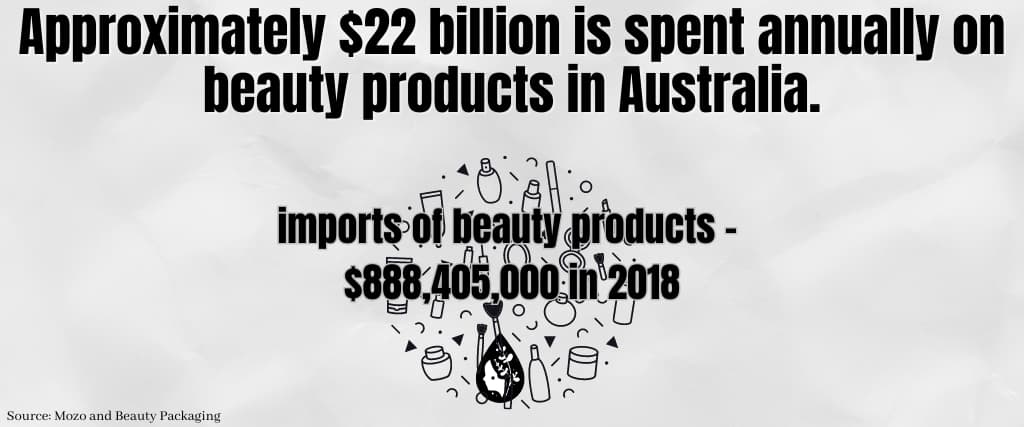
2. Approximately $22 billion is spent annually on beauty products in Australia.
According to Mozo and Beauty Packaging, Australians shell out a whopping $22 billion annually on beauty products. This includes purchases of beauty products and imports of beauty products – $888,405,000 in 2018. And that’s not just cosmetic procedures, Australians spend an estimated $1 billion annually on cosmetic procedures.
3. Australian women’s average annual beauty industry expenditure is $3,600.
According to Roy Morgan, Beauty Packaging, and Mozo, in Australia, women are the leading consumers in the beauty industry, with an average yearly spend of $3,600 on all things beauty-related. This is because 2.1 million millennial women in Australia buy new skincare products at least once every six months.
But it’s not just women driving the beauty market – men are also getting in on the action. In fact, millennial men in Australia also use beauty products, with approximately 16% of them purchasing makeup. Although men may not spend as much as women, they still invest in their grooming. 16% of men opt for pedicures and manicures, spending $736 million a year on nail care.
Overall, women in Australia spend a whopping $15 billion each year on grooming products, while men spend a still-impressive $7 billion. Despite the differences in spending, one thing is clear – both women and men in Australia place a high value on looking and feeling their best.

4. The cosmetics industry in Australia has its largest consumer base in Queensland.
According to Beauty Packaging, Queensland is the largest cosmetic industry market in Australia. The region has an average annual spending of $989 per person on beauty products. South Australia follows closely with an average spending of $986 per person, and New South Wales also has a substantial average expenditure of $934 per capita on beauty products.
5. The Personal Care sector dominates Australia’s beauty industry.
According to Statista, the Personal Care segment is the dominant sector in the beauty industry in Australia. With a $3,391 million revenue in 2021, this industry is expected to continue its steady growth with a 5.8% estimated increase in the next four years, reaching a projected revenue of $3,737 million in 2026.
Personal hygiene products are highly sought after in the Personal Care segment, holding a commanding 80% market share. Closely following, oral and dental care products hold a strong 78% market share. These impressive figures demonstrate Australia’s ongoing demand for top-notch personal care products.
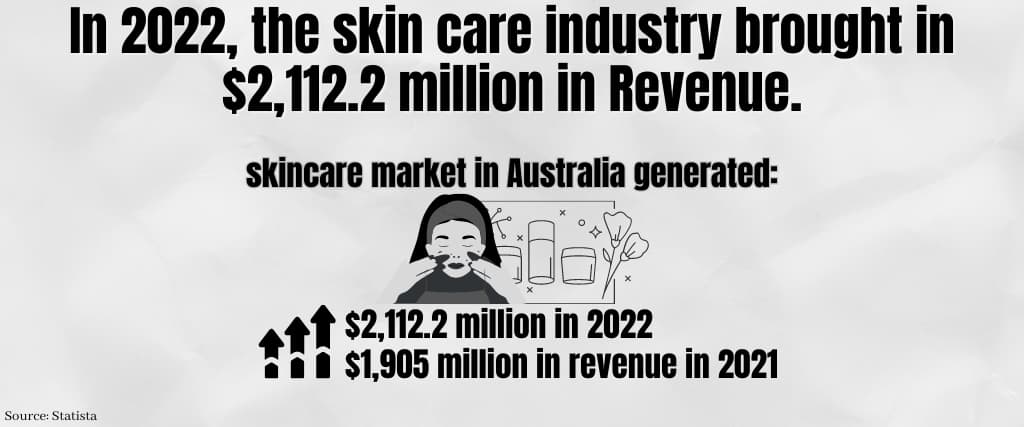
6. In 2022, the skin care industry brought in $2,112.2 million in Revenue.
According to Statista, the skincare market in Australia generated a total of $2,112.2 million in 2022. Products in this category have consistently gained popularity, with an estimated $1,905 million in revenue in 2021. Fragrances also performed well, with a projected annual growth rate of 2.37%.
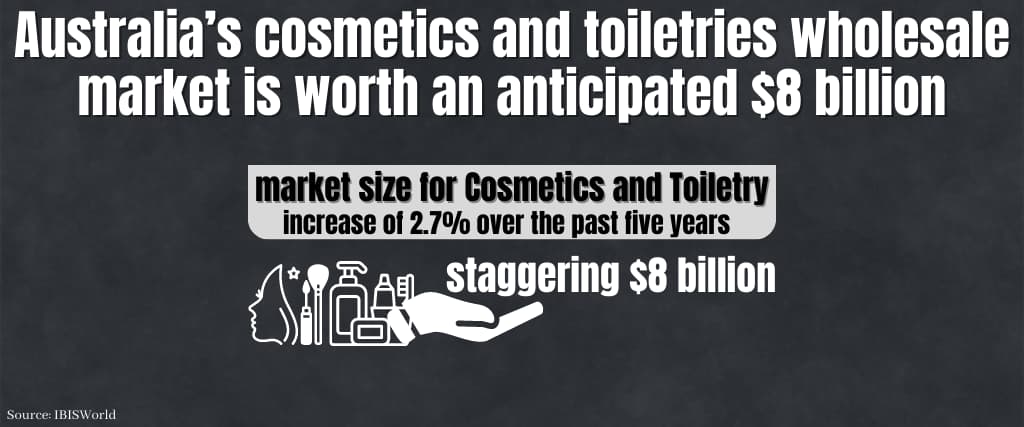
7. Australia’s cosmetics and toiletries wholesale market is worth an anticipated $8 billion
According to IBISWorld, the market size for Cosmetics and Toiletry Wholesaling in Australia is a thriving industry, estimated at a staggering $8 billion. This sector has experienced substantial growth in recent years, with a revenue increase of 2.7% over the past five years. The future looks bright for this industry, with projections forecasting a continued upward trend and a revenue increase of $8.2 billion.
An Analysis of Australia’s Beauty Market
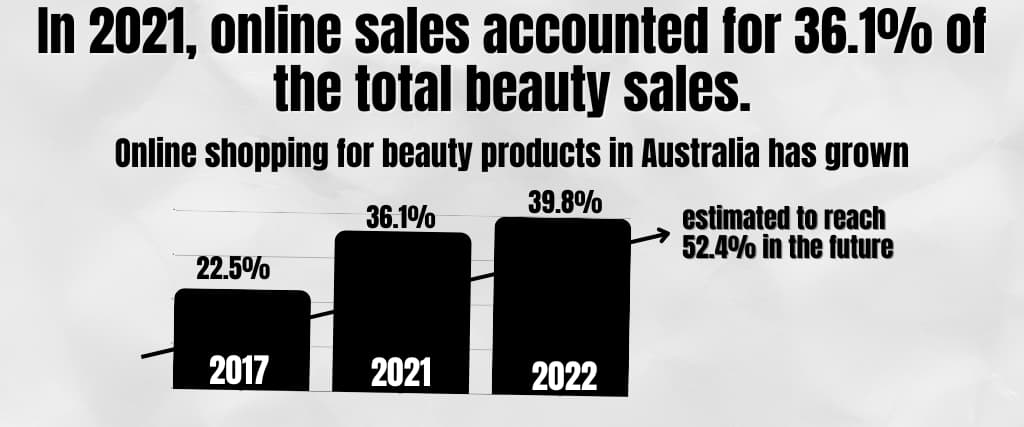
8. In 2021, online sales accounted for 36.1% of the total beauty sales.
Online shopping for beauty products in Australia has grown in recent years, accounting for 36.1% of all beauty sales in 2021. This is an increase from the 22.5% of online shoppers in 2017. Online shoppers make up 39.8% of the market in 2022, and it is estimated to reach 52.4% in the future.
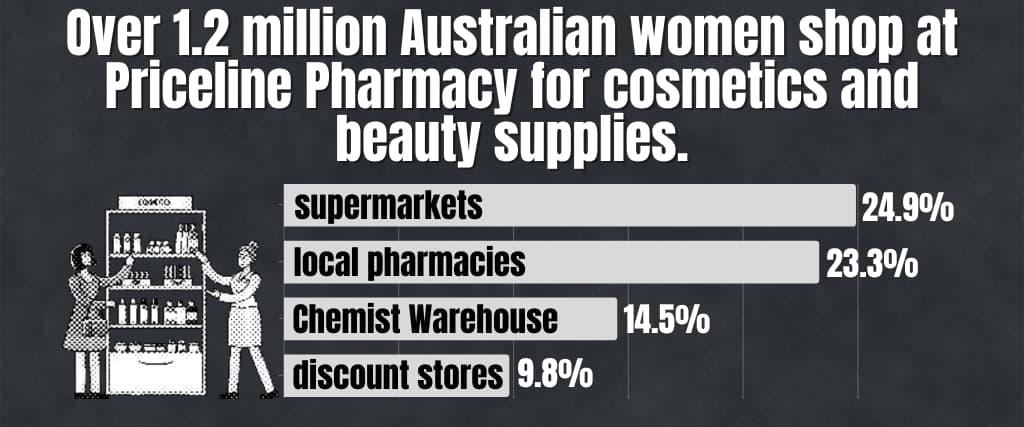
9. Over 1.2 million Australian women shop at Priceline Pharmacy for cosmetics and beauty supplies.
Despite the rise of online shopping, many Australian women still prefer to purchase their beauty products in physical stores. According to Roy Morgan, 1.2 million Australian women buy their makeup at Priceline Pharmacy, with 24.9% of women purchasing from supermarkets and 23.3% from their local pharmacies. 14.5% of women buy from Chemist Warehouse. 9.8% buy from discount stores.
10. 33% of online beauty shoppers followed or liked a cosmetics brand in 2019.
Social media significantly influences Australian consumers’ discovery and engagement with beauty brands. According to We Are Social, 33% of beauty buyers online have followed or liked a brand, with 41% discovering new brands through social media profiles. Additionally, 23% have followed a sponsored or promoted link. 19% have sent a message to ask a brand a question. Using celebrity and influencer marketing by online beauty brands has also successfully gained consumer attention.
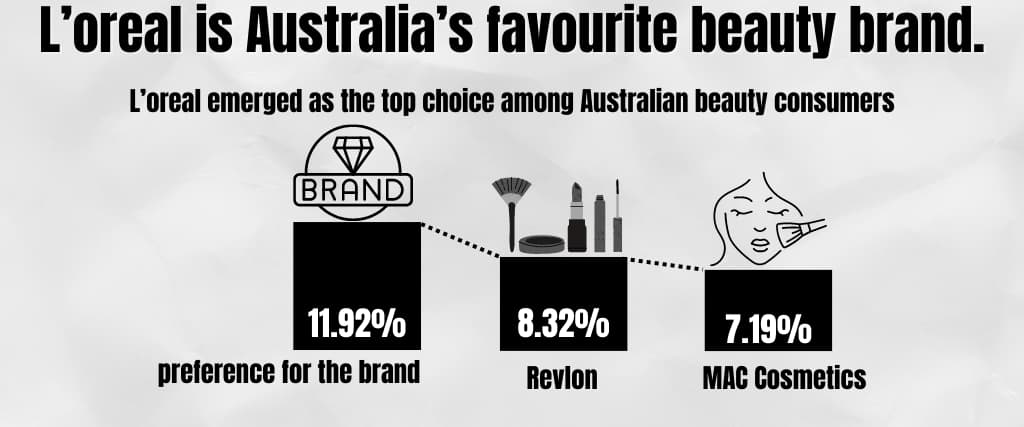
11. L’oreal is Australia’s favourite beauty brand.
In a 2019 survey, L’oreal emerged as the top choice among Australian beauty consumers, with 11.92% of respondents indicating their preference for the brand. Revlon came in second place, with 8.32% of the vote, followed closely by MAC Cosmetics with 7.19%.
12. Nude by Nature is among the country’s best-selling cosmetics lines.
The Beauty Industry is a constantly growing and evolving market, with big global players like MAC & Maybelline dominating the scene. However, 58.94% of consumers opt for alternative, non-global brands as their go-to. A study by Roy Morgan in Australia reveals that a staggering 23% of women who purchase beauty products choose to support local, Australian-made brands. Nude by Nature leads the pack, with Natio and Napoleon hot on its heels.
Aussies are fiercely proud of their homegrown beauty brands. These companies put in the extra effort to ensure their products are effective and cruelty-free, contributing to the animal rights movement. This resonates with Aussie consumers, who are passionate about supporting brands that align with their values. By choosing local, they know they’re getting top-notch beauty products while making a positive impact.
An Analysis of Employment in the Beauty Industry
13. Women make up most of Australia’s cosmetics industry employers.
The Beauty Industry in Australia is a beacon of female empowerment, with women leading the charge as consumers and employees. The latest statistics reveal that nearly half (48.81%) of all full-time workers and close to half (49.79%) of part-time employees in the beauty industry are women. Meanwhile, men only make up a mere 0.69% of full-time employees and 0.71% of part-time employees in the personal care sector.
This trend is reflected in the number of businesses in the beauty & hairdressing industry, where 35,000 businesses employing 80,000 people are dominated by women, with a staggering 97% of the workforce being female.
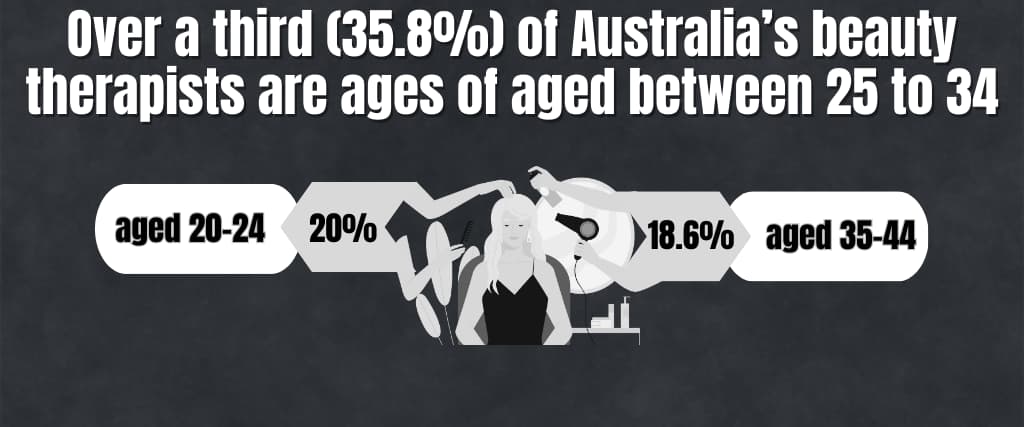
14. Over a third (35.8%) of Australia’s beauty therapists are ages of aged between 25 to 34.
Most beauty therapists in Australia are between the ages of 25 and 34, with 35.8% working in the industry. 20% of the beauty therapy workforce is comprised of young adults aged 20-24, while those aged 35-44 make up 18.6% of employment rates.
15. Half of Australia’s beauty-related qualifications were conferred by TAFEs.
Australia is home to a thriving beauty industry, and to keep up with its growth, many seek to acquire beauty-related qualifications. In 2020, 21,490 Australians enrolled in such programs, with 55% of enrolments leading to a certificate III. 26% lead to a higher-level qualification, such as a diploma.
TAFE institutes specialise in providing makeup & beauty services qualifications. Private training providers offer a wide range of specialised qualifications, including beauty therapy, nail care technology, and laser hair removal.
16. Around a third (34%) of those who enrol in beauty programs do so, hoping to find work in the beauty therapist field.
According to the latest data from the Australian Industry & Skills Committee, beauty therapy is the most in-demand job in the beauty industry, with 34% of people enrolling in beauty-related programs showing interest in pursuing this career path. Hairdressing, massage therapy, and makeup artistry are also popular career choices, with beauty services accounting for 29% of program enrolments and makeup accounting for 16%.
One of the top employers in the beauty industry is JustCuts, one of Australia’s biggest franchises. This shows a wealth of opportunities for those with the right qualifications and skills. The beauty industry is a thriving and lucrative sector with plenty of room for growth and advancement.
17. In 2019, beauty therapist employment reached a record high of 41.8%.
The beauty therapist industry experienced its greatest employment levels in 2019, with a share of 41.8%. However, the COVID-19 pandemic resulted in a sharp drop in employment levels, which plummeted to 20.4%. Despite this setback, the industry has rebounded, and employment levels have improved to 35.8%, and it is expected to reach 50.7% by 2025.
Analysis of Trends in the Beaty Industry
18. The COVID-19 regulations led to an 84% increase in earnings for hair salons.
COVID-19 restrictions significantly impacted the beauty and personal care industry in 2021, leading to a surge in spending in certain sectors. The hair care sector was one of the biggest beneficiaries, with hair salons reporting an 84% increase in revenue in the fourth quarter of 2021, compared to the same period in the previous year. Meanwhile, beauty salons experienced a rapid 112% rise in income during the same quarter, demonstrating the industry’s resilience in the face of adversity.
19. Almost half of the Australian women (46%) would not purchase cosmetics if animal testing was involved.
Animal welfare is becoming increasingly important to Australian women when choosing beauty products. In a recent survey by Roy Morgan, 46% of women said they would avoid cosmetics if tested on animals, a significant increase from 2012 when just 39% of women considered animal testing a factor in their purchasing decision.
One brand that has capitalised on this shift is Nude by Nature. The Australian brand, known for its cruelty-free and vegan cosmetics, has seen a 61.2% increase in the likelihood of purchase among consumers.
Get Ready for a Beauty Blast-Off!
The beauty industry in Australia is soaring higher than ever before, and the numbers don’t lie! The market is booming, and the best news of all, the sky’s the limit! With the surge of online shopping, the beauty industry is set to soar even higher and take over as the leading sales channel, unlocking endless opportunities for cosmetic brands. Imagine beauty subscription services at your fingertips, AI technology, and personalised skincare tailored just for you – the beauty revolution is here, and it’s time to jump on board!
FAQs
How many Australian beauty businesses are there?
According to the IBISWorld and Women’s Agenda data, the number of Hairdressing and Beauty Services in Australia is estimated to be around 33,520. Some studies put this figure closer to 35,000. Regardless of the exact number, it is clear that the beauty industry in Australia is thriving.
Which nation is home to the largest beauty industry?
According to Statista, the United States leads the global cosmetics industry, generating an impressive $113,036 in 2022. China comes in a close second, with a total of $77,961, while Japan follows closely behind with $53,932. These three countries are at the forefront of the beauty industry, paving the way for innovation and growth.
In 2020, what was the beauty industry’s total revenue?
2020 was a remarkable year for the beauty industry, with worldwide spending totalling an astonishing US$483 billion, according to Terakeet. This impressive number showcases the continued demand and love for beauty and self-care products, even amidst the challenges of a global pandemic.
What is the value of the cosmetics market?
The beauty industry’s future is looking even more radiant as the global market is expected to grow at a rate of 4.75%, with projections reaching an incredible $716 billion by 2025, according to Terakeet.
5. How extensive is Australia’s beauty industry?
According to Statista, the Australian beauty industry is booming, with a revenue increase of 10.9% in 2022, quickly bouncing back from the impact of the Covid-19 pandemic.